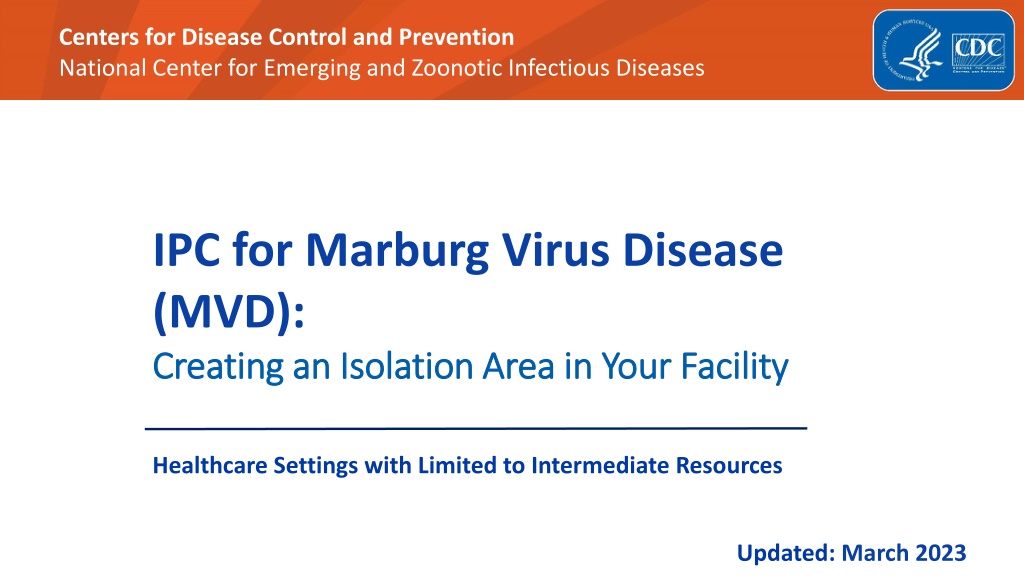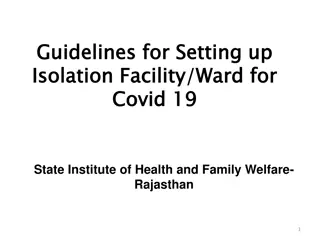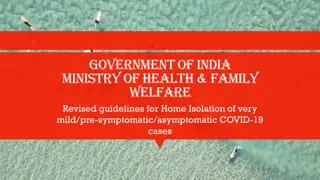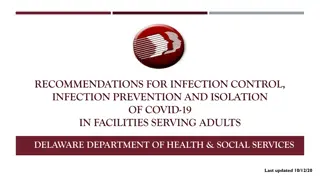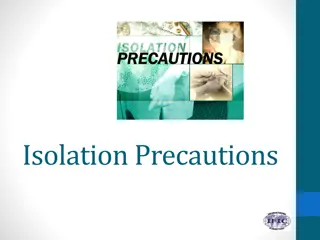Guidelines for Setting Up Isolation Area in Healthcare Facilities
Learn about the importance of isolating suspected Marburg virus disease patients in healthcare settings to prevent spread. Discover best practices for creating a short-term isolation area and the requirements for setting up an effective isolation space, ensuring the safety of patients and healthcare workers.
Download Presentation

Please find below an Image/Link to download the presentation.
The content on the website is provided AS IS for your information and personal use only. It may not be sold, licensed, or shared on other websites without obtaining consent from the author. Download presentation by click this link. If you encounter any issues during the download, it is possible that the publisher has removed the file from their server.
E N D
Presentation Transcript
Centers for Disease Control and Prevention National Center for Emerging and Zoonotic Infectious Diseases National Center for Emerging and Zoonotic Infectious Diseases Centers for Disease Control and Prevention IPC for Marburg Virus Disease (MVD): Creating an Isolation Area in Your Facility Creating an Isolation Area in Your Facility Healthcare Settings with Limited to Intermediate Resources Updated: March 2023
Learning Objectives Learning Objectives After this presentation, participants will be able to Explain why isolating suspected Marburg virus disease patients is important Describe at least 3 best practices for setting up a short-term isolation area for suspected Marburg virus disease patients
Discuss Discuss Why is it important to keep people who might have Marburg virus disease (MVD) isolated from other patients in a healthcare facility?
Early identification and separation of suspected Marburg virus disease patients prevents bringing unrecognized Marburg virus disease into your healthcare setting. This protects YOU Your co-workers & patients Your community
Setting Up an Isolation Area Setting Up an Isolation Area
Isolation Isolation When a suspect Marburg virus disease patient is identified, the patient should be isolated to prevent spreading the illness to others. Every facility should have space identified that can function as isolation until the patient can be transferred to a designated facility for testing and care.
Isolation Area Requirements Isolation Area Requirements Separate from other patient care areas, such as: Separate building Temporary structure/tent Demarcated area (under a tree) Designated for use only as Marburg virus disease isolation Should not be dual purpose Restricted access Fencing, taped off, etc. Only healthcare workers should enter isolation (to give oral medicines, etc.)
Isolation Area Design Isolation Area Design Unidirectional flow Ideally, separate entrance and exit Dedicated spaces for putting on and removing PPE Separate patient care supplies Appropriate spacing At least one meter between beds Supplies to hold patients temporarily and safely Separate toileting options for each patient (e.g., latrine or commode bucket) Hand hygiene stations
Isolation Area Equipment & Supplies Isolation Area Equipment & Supplies Patient care (IF REQUIRED) Cleaning and disinfection 0.5% chlorine solution (for disinfection) or other approved hospital disinfectant* Soap and water Cleaning equipment (buckets, cloths, mop) Waste For patients Chairs, or bench if no chairs available Food and water Hand hygiene station Separate toilet or latrine PPE for healthcare workers Hand hygiene stations for healthcare workers Designated patient care equipment Biohazard waste bin (red) General waste bin * Alcohol at 70-90% (ethanol, isopropyl), improved hydrogen peroxide 0.5%
PPE Removal Area Equipment & Supplies PPE Removal Area Equipment & Supplies The PPE removal area should have: Bucket of strong (0.5%) chlorine solution (for non-porous items, such as boots, goggles) Bucket of mild (0.05%) chlorine solution (for porous items, such as cloth gowns) Container with a lid for infectious waste Container for reusable PPE Hand hygiene supplies Biohazard waste bin (can be yellow or red) Bucket for dirty, reusable PPE to be reprocessed
Example Facility Setup Example Facility Setup Suspected Marburg Patient Area Non-Marburg Suspect Patient Care Area
Reflection Reflection How is the isolation area for Marburg virus disease different from other isolation areas you might have had to set up in the past? What challenges has your facility had in the past with setting up isolation areas? If you have never had to participate in setting up an isolation area, what challenges do you imagine your facility might have?
Key Takeaways Key Takeaways Isolation prevents people sick with Marburg virus disease from spreading the illness to others. It protects you, your co- workers and patients, and your community. Every facility should have a separate isolation area for suspected Marburg virus disease patients until they can be transferred to a designated facility for testing and care.
Thank you! For more information, contact CDC 1-800-CDC-INFO (232-4636) TTY: 1-888-232-6348 www.cdc.gov TTY: 1-888-232-6348 www.cdc.gov For more information, contact CDC 1-800-CDC-INFO (232-4636) The findings and conclusions in this report are those of the authors and do not necessarily represent the official position of the Centers for Disease Control and Prevention. official position of the Centers for Disease Control and Prevention. The findings and conclusions in this report are those of the authors and do not necessarily represent the
